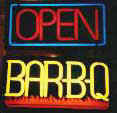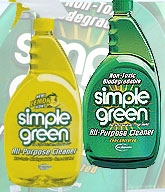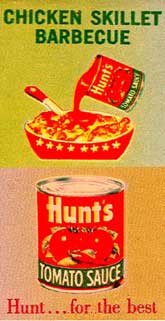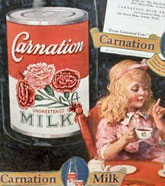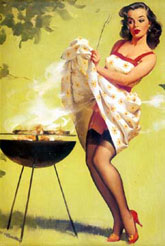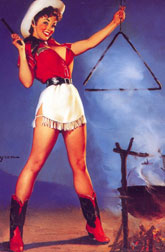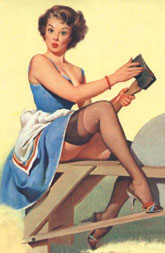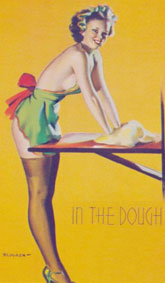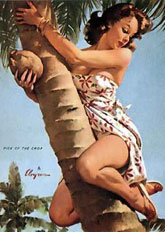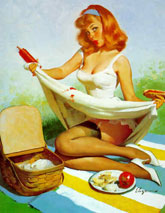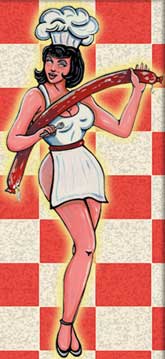Contact BBQbyDan
www.BBQDan.com
Search
KCBS BBQ Cook-Off Info
Recipes,
Smoking Meats
Recipes, Grilling
|
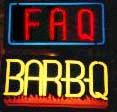 |
FAQ OF THE INTERNET BBQ LIST Version 2.0 Section 6 Hardware--Accessories |
-------------------
[Do I really need a thermometer in my smoker?]
Tom Kelly--
Unless you're one of the real pro's out there, you need a thermometer. Even if you have one of those Brinkmann "COLD-IDEAL-HOT" indicators, you need to know what temperature it's really indicating. Also, if you have a thermometer that's not at grill level, you need to know how close it reads to an accurate thermometer placed at the grill level so you can use your installed thermometer as a guide.
You have a lot of choices here. Thermometers range from $3 home oven types to $30 or more dial indicator or digital remote reading units. You'll have to decide what's best for you. Here's some information to help you make that choice:
Oven Thermometer - These $3 or so units will work fine. You can get them at K-Mart, WalMart, Roses or stores that carry kitchen accessories. Set it on the grill and smoke away. The two big drawbacks are, 1) you have to raise the lid to check the temperature (and that causes heat loss) and 2) you have to clean the face of it just about every time you use it use because the smoke will totally coat the face. Also, over time, the smoke products can muck up the spring mechanism (through the small holes in the back) so plan on buying a new one after a few years, depending on the amount of use.
Built-in Thermometer - These dial indicator thermometers are available for about $30. Brinkmann and New Braunfels make them to fit the threaded hole in the cooking chamber lid. They have a range of about 50 to 500F. The element (probe) is inside the smoke chamber and the dial is outside so you don't have to open the unit to check the temperature and the face and mechanism don't see the smoke. The only problem may be the placement of the thermometer. On the Brinkmann SnP Pro and the NBBD and Hondo units, the thermometer is 4 to 8 inches above the grill level so the indicated temperature may read as much as 60F higher than the grill temperature. Several other instrument companies also make dial indicator thermometers and some are available on the Internet.
[Editor--if you want to install a dial-indicating thermometer in the door of your NBBD/Hondo or SnP Pro, we suggest that you look into a more accurate unit than the ones sold by New Braunfels or Brinkmann. Several manufacturers (like Ashcroft) sell industrial-grade stainless steel Bi-metal barbecue thermometers that will thread right into the hole in the cooking chamber door. These units can be purchased for about $30. You will also need to order a keeper nut for about $1. You can get these thermometers from several places, including BBQ Pits by Klose, by phone or from their Web site.]
Remote-Reading Thermometer - Polder makes a very nice remote-reading thermometer for about $30. You can buy the Polder unit at many barbecue supply stores and over the Internet from Cunningham Gas products. These electronic units have a 4 or 5 inch probe which can be placed in the smoker. A metal braided shielded wire runs from the probe to an LCD readout placed outside the chamber. The probe can be positioned anywhere within the smoker to obtain a fast and accurate temperature indication. These units are excellent for ‘calibrating' your installed dial indicator thermometer because it shows the difference between the grill level and the dial indicator location. Sunbeam made a similar unit, but reports in early 1998 said that the Sunbeam digital thermometer was out of production.
Other types - Some folks have reported that a candy thermometer, poked through the center of a cork that fits a hole into the cook chamber works fine. There are probably lots of alternate solutions.
==============Rock--
I have the Perfect Temp by Charcoal Companion, and as far as I can tell, it's identical to the Polder in every way except for brand name. I bought mine from the Barbecue Store on the Internet. It works just great!
==============Scott--
I've got both the Polder and the Charcoal Companion (don't know if that's a Sunbeam or not) and I can't tell a bit of difference other than the Charcoal Companion has different printed instructions, like maybe Polder sells the thermometers to the company and then they print their own instructions (and the Polders are white while the CCs are black). Even came with the same brand of battery (El Cheapo Hong Kong Industrial Grade Alkaline, guaranteed to last nearly 2.3 minutes). Probes are the same length, display is identical down to the size and placement of numbers. They were also priced identically - $29.95.
==============Editor--
Be sure and check out the accuracy of you digital thermometers often. Place them in boiling water and they should read 212F or less if you are at some altitude above sea level. My home is at 2100 ft. ASL and my Polder reads 206F in boiling water. If your Polder is acting weirdly, it is sometimes necessary to remove the battery from the unit and then reinstall it to reset them.
6.1.1 Pros and cons of thermometers
-------------------[Do I really need a thermometer? An old-timer told me not to bother with one.]
The old-timers on the List don't use thermometers and say they are not needed. Beginners seem to want and need them. Seems that once you're an old-hand at barbecue, then you can tell the temperature by the color of the smoke, the smell of the smoker or by some extra-sensory thing. But until you get to that point, a thermometer somewhere in the smoker is an absolute necessity.
6.1.2 Where should I measure the temperature?
--------------------[What's the best way to place the thermometer in the smoker so I'll know what the smoker temperature is? And do you guys leave the temperature probe in the smoker the entire time you're smoking?]
Editor--A summary of several posts--
Remember, the important place to measure the temperature in the smoker is at the meat. This is also not the easiest place to measure the temperature. Most smokers come with a thermometer in the lid, whether it's a bullet smoker or an off-set firebox smoker. The temperature measured at this point, in the lid, can be 50-70F higher than at the meat cooking rack. If your smoker has upper and lower racks, the top rack will be 20-50F higher than the lower rack. None of these things is a big problem once you learn your smoker. For the beginner, we suggest that you equip your smoker with a good analog thermometer in the dome or lid. A candy thermometer works well (you need a range of about 150F to 350F). Use this thermometer to monitor and control the temperature inside your smoker. A digital meat thermometer that you can poke into the meat is well worth the investment of $30. Once you understand the temperature profiles within your smoker, then you can stop using the digital thermometer and rely on the one in the dome or door. Also remember that in your horizontal smoker (SnP Pro, NBBD, Klose, OKJ's, etc.) the temperature at the meat rack will be highest near the firebox and coolest at the opposite end.
Like we've said before, you've got to put some heat to the meat and experiment with your smoker to get good at doing barbecue. Nothing beats experience. A whole chicken costs about $5 and is a good way to begin working with your smoker. You're not going to go bankrupt if you ruin a few chickens and chances are you won't ruin any. See Section 10.3.4 on how to prepare the chicken before it goes into the smoker.
==============Belly--
This is the way I do it. I stick the digital thermometer probe through a potato, with the end sticking out about 2 inches. This keeps the tip off the hot metal of the grill. That way I can know for sure what the true grill temperature is and I can move that tater around to measure temperature at different places. I leave it the whole time I'm smoking. As for measuring the temperature inside the meat, I don't do it. I just use my old fork on the meat to tell when it's done. Well, that the way this old county boy do it.
==============Kurt Lucas--
I never stick a thermometer into any meat I barbecue. I only use the thermometer to watch the temperature at the cooking level. If the temperature of the smoker is watched closely and maintained properly, checking the meat temperature is not necessary. The only time it's necessary to measure the temperature of the meat is when you are doing cuts of meat that you want to cook to a temperature other than "well done".
==============Vince Vielhaber--
When I'm going to use one, I put the temperature probe in at the beginning and leave it there the whole time I'm smoking. I bring the cable through a hole in the front of the NBBD.
==============Terry Light--
I have a Polder and 2 Sunbeams thermometers. I always use 2 when cooking outside, usually stick one probe through the corner of whatever meat I'm cooking so the end is in the air right at the meat level to measure smoker temperature and I put the other probe in the center of the meat.
==============Editor--
One thing that the digital temperature probes are really good for is to tell beginners when to take off the meat. With one of these probes, it is easy to tell when meats like pork loin, beef tri-tips and poultry are done as these meats are ruined by overcooking.
--------------------
[What kinds of tools are handy for barbecuing?]
Tom Kelly--
RIB RACKS - If you have a small bullet water smoker, you might want to consider a rib rack. These racks allow you to stand a rack or slab of ribs on edge, instead of laying them flat, thus freeing up valuable grill space. They are available at barbecue stores, some home centers, better kitchen stores and restaurant supply houses. Usual cost is about $20. UTENSILS - A set of long spring-loaded barbecue tongs are indispensable for picking up and moving meats, especially ribs. A large fork or spatula is also handy for checking doneness and transferring the cooked meat to a serving platter or to a roasting pan for covered cooking. FIREPLACE TONGS - These are useful for messing with the fire and for adding chunks of wood or charcoal to the firebox. Get the smallest ones you can find as you aren't going to be moving fireplace-sized logs around in your smoker. If you pre-burn your wood, the tongs are great for transferring coals to the smoker's firebox. SPRAY BOTTLE - Nope, not for putting our grease fires! A spray bottle is ideal for applying thin mops, such as apple juice, beer or soda, which do not contain ingredients that would stop up the sprayer nozzle. DRIP PANS - These accessories come in many shapes, sizes and materials. The bottom line is that a drip pan, placed under the meat, can help keep your cleanup requirements to a minimum. Instead of washing out the smoke chamber, you simply clean out the drip pan. For even easier cleanup, line the pan with aluminum foil and just fold up and throw away the foil after smoking. COOKING PANS - A nice aluminum, stainless steel or porcelain roasting pan is a handy smoking item but be aware, it'll turn black over time!. Many folks like to finish their product in a covered pan, either in the smoker or in the oven. A shallow roasting pan, covered with aluminum foil, works great for this purpose. WATERING CAN or FUNNEL - Many of the bullet water smokers have horrible access to the water pan. Refilling the water pan can be dangerous and difficult. A long, flexible funnel or a gardener's watering can makes replenishing the water pan a breeze. CHIMNEY STARTER - This is one of the most indispensable items for anyone using lump charcoal or briquettes. They are available at home centers (Lowe's, Home Depot, HQ, etc.) for about $10. Basically, it is an open metal cylinder with a grate near one end. You fill it with fuel which sits on the grate, crumple up newspaper underneath the grating and light it. In 15 - 30 minutes, you are ready to pour the contents into your firebox or firepan and get to smoking. COOLER - A standard insulated chest or drink cooler, size determined by your needs, is an invaluable tool for barbecuing. Often, the meat, particularly brisket, is removed from the smoker, wrapped in several layers of foil, and placed in a cooler. This ‘resting' period continues the cooking process (without you having to tend the smoker and burn fuel) and tenderizes the meat further while holding in heat. A brisket can be safely kept in a cooler if it's wrapped in towels for additional insulation for 6-7 hours prior to serving. Remember, meat must be kept at a temperature above 140F for safe storage. BEER HOLDER - Self explanatory. You or anything else that keeps your beer handy and cool while you slave over the smoker. BASTING BRUSH and MOP - You should have one of each. Both should have long handles. A mop is used for thinner sauces and a basting brush for thicker ones and for honey, butter and oils. These are available in barbecue stores, kitchen shops, supermarkets and discount stores. They are available from $2 to $9. Always slip back the sleeve covering the top part of the mop or brush when you put these into the dishwasher after use. This will clean the top portion of the mop or brush. WATER CAN - Some people who have off-set firebox smokers like to have some added humidity to the smoke, just like the bullet smoker people get. To accomplish this, an old coffee can (paint burned off) set in the firebox will do the trick. Alternatively, a small loaf pan, filled with water and set in the smoke chamber in front of the firebox opening has basically the same effect. FOOD GLOVES - When handling the meat, particularly after smoking, a nice pair of rubber gloves is handy. Helps keep the meat clean and also helps keep from burning your hands if the meat is too hot. There are some gloves that are FDA approved for food handling, such as those made by Edmont. CHICKEN RACK - A chicken rack is available at barbecue stores, better kitchen stores and at some home centers. Some consist of a pan with a center cone attached to the pan while others are fabricated from a wire frame. In either case, the chicken sits upright. On the cone type, the hot air and smoke can get to the inside of the bird as well as the outside. It is also supposed to save some space if you have a small cooking surface, depending on the size of the rack's footprint. JACQUARD - This item is available only at specialty kitchen stores and kitchen item suppliers. It consists of a row of tiny blades (as few as 9 or as many as 36) which are used to tenderize the meat. This tool is plunged into the meat many times and it cuts the fibers. Probably not an item required for the backyard chef. INSULATION - If you smoke in a cold climate, you might consider insulating your smoke chamber. Brinkmann makes a "Smoking Jacket" for some of its smokers. A water heater blanket may work just as well but be sure there are no combustible materials adjacent to the chamber. A piping system insulation manufacturer would also have a suitable product. WARNING: IF YOU INSULATE, MAKE CERTAIN THAT THE MATERIAL IS ENCLOSED AND CANNOT ESCAPE ONTO YOUR FOOD AND THAT IT WILL WITHSTAND THE TEMPERATURES YOU EXPECT ON YOUR UNIT. CHIP BOX - These small metal boxes are designed to hold wood chips. The box is placed on a bed of coals or just above an electric or gas element and produces smoke.Return to the Table of Contents
Return to the BBQ FAQ Home Page
Comments or Suggestions
BBQ FAQ Ver 2.0 ©1997, 1998 William W. Wight. All rights reserved.

